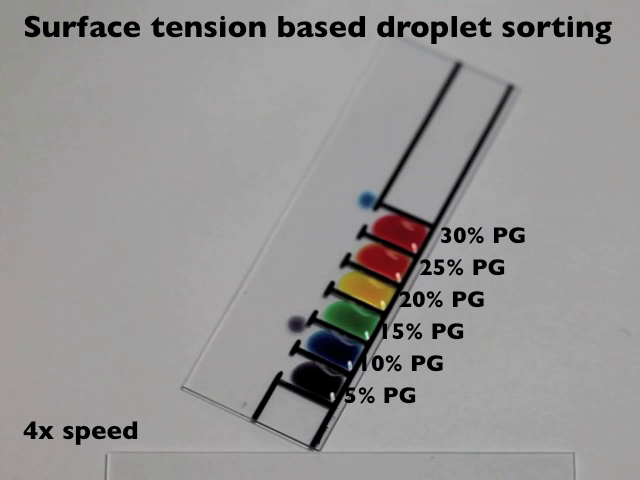Watch ‘Intelligent’ Blobs Sort Themselves by Surface Tension
Back in 2009, an extraordinary demonstration took place at Northwestern University in Evanston Illinois. The protagonist in this display was a blob of oil and its goal was to find its way through a maze.

The blob set out on its task hesitantly, sometimes wavering before choosing its route as if pondering the road not taken. When it took a wrong turn, it even retraced its steps and continued towards its goal.
And in the end it got there. A blob of oil navigated its way from one side of a maze to the other, making seemingly intelligent decisions along the way. That’s more than many humans can manage at Hampton Court on a Sunday afternoon.
The Northwestern team videoed the feat so that disbelievers could watch it later. You can watch the video here.
There is a trick, of course. The maze is filled with a solution of potassium hydroxide which is strongly alkaline. And at the exit is a chunk of gel soaked in hydrochloric acid, which then diffuses into the maze setting up a pH gradient.
This gradient causes a difference in surface tension around the blob that pushes it along. So the blob simply follows the pH gradient, eventually finding its way to the chunk of gel at the exit.
At one level, that’s amazing—a blob of oil making seemingly intelligent decisions to solve a maze. But at another level, it’s entirely expected. The solution to any maze is encoded in its geometry so it’s no surprise that it’s possible to design a dumb experiment that exploits this.
But if blobs can solve a maze, what else can they do? Today, we get an answer thanks to the work of Nate Cira and Manu Prakash at Stanford University in California.
These guys have used a similar phenomenon to create blobs that push each other around (they mix in food dye to make the blobs easier to see). They even use the blobs to make simple machines that produce circular motion, oscillations or one machine that sorts blobs by surface tension. That has implications for technologies such as microfluidics in which chemicals are pumped through microscopic channels inside tiny laboratories.
They’ve made a video of their work which they are entering into this year’s Gallery of Fluid Motion at the American Physical Society. The video is here (hi-res video 61.6MB , or low-res video 31.9 MB).
If you’ve got 3 minutes to spare, download and watch it. You’ll be amazed how useful ‘intelligent’ blobs can be.
Ref: http://arxiv.org/abs/1310.3847 : Dancing Droplets
Keep Reading
Most Popular
Large language models can do jaw-dropping things. But nobody knows exactly why.
And that's a problem. Figuring it out is one of the biggest scientific puzzles of our time and a crucial step towards controlling more powerful future models.
How scientists traced a mysterious covid case back to six toilets
When wastewater surveillance turns into a hunt for a single infected individual, the ethics get tricky.
The problem with plug-in hybrids? Their drivers.
Plug-in hybrids are often sold as a transition to EVs, but new data from Europe shows we’re still underestimating the emissions they produce.
Stay connected
Get the latest updates from
MIT Technology Review
Discover special offers, top stories, upcoming events, and more.